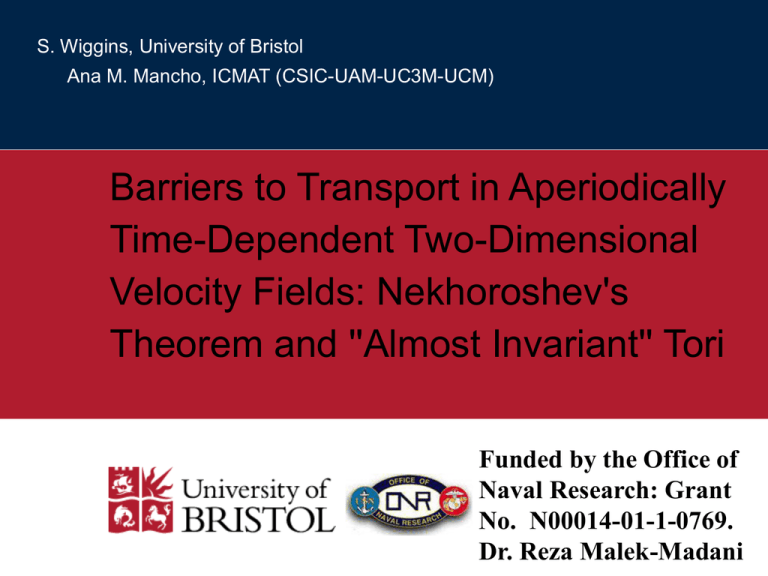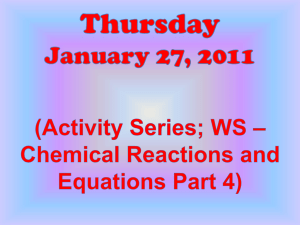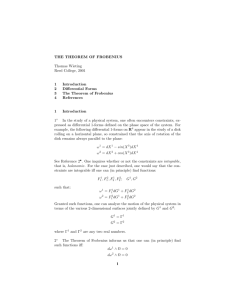
S. Wiggins, University of Bristol
Ana M. Mancho, ICMAT (CSIC-UAM-UC3M-UCM)
Barriers to Transport in Aperiodically
Time-Dependent Two-Dimensional
Velocity Fields: Nekhoroshev's
Theorem and ''Almost Invariant'' Tori
Funded by the Office of
Naval Research: Grant
No. N00014-01-1-0769.
Dr. Reza Malek-Madani
Plan for the talk
2
•The Dynamical Systems approach to Lagrangian transport:
Motivation and Background
Mathematical issues (and some history) associated with general time
dependence, and finite time dependence
•Issues associated with the application of the KAM theorem and
Nekhoroshev’s theorem.
•A Nekhoroshev theorem for two-dimensional, aperiodically time
dependent velocity fields
•Some examples
3
Original Connection with Dynamical Systems
Theory: 2-D, Incompressible, Time-Periodic
Flows
Phase Space
Reduction to a 2-D,
Area Preserving,
Poincare Map
Physical Space
Dynamical Systems Structure
Implications and Uses for
Fluid Transport
4
Geometrical Template Governing
Invariant Manifold
(material curve, surface)
Transport. Basis for Analytical and
Computational Methods for Computing
Transport Quantities
Probably implies rapid stirring
Chaos
(at least “somewhere”)
Trapping of Fluid. Barriers to Transport
KAM Tori
5
Early dynamical systems analysis of Lagrangian transport was
applied to kinematic models, but do these mathematical
results and techniques work for “real problems”? (Some do, and
some don’t)
What is a “real problem”?
(It should be related to “data”)
What are the issues and obstacles?
Aperiodicity in Time
“Finite-Time Velocity Field”
6
For finite time, aperiodically time-dependent velocity fields
what about……….
•Poincaré maps? (More generally, “how is dynamics
generated and described by the velocity field?”)
•Hyperbolic trajectories?
•Stable and unstable manifolds of hyperbolic trajectories?
•Chaos?
•Lyapunov exponents?
•KAM tori?
and many other “dynamical systems” concepts and
quantities????
Some relevant mathematical results: nonautonomous systems
7
Generating the dynamics (no flow, or single map)
Dafermos, C. M. (1971). An invariance principle for compact processes. J. Diff. Eq., 9, 239–252.
Miller, R. K. (1965). Almost periodic differential equations as dynamical systems with
applications to the existence of almost periodic solutions. J. Diff. Eq., 1, 337–395.
Sell, G. R. (1967a). Nonautonomous differential equationa and topological dynamics I. The basic theory.
Trans. Amer. Math. Soc., 127(2), 241–262.
Sell, G. R. (1967b). Nonautonomous differential equationa and topological dynamics II. Limiting equations.
Trans. Amer. Math. Soc., 127(2), 263–283.
Stable and unstable manifolds of hyperbolic trajectories
Coddington, E. A. and Levinson, N. (1955). Theory of Ordinary
Differential Equations . McGraw-Hill, New York.
de Blasi, F. S. and Schinas, J. (1973). On the stable manifold theorem for discrete time dependent
processes in banach spaces. Bull. London Math. Soc., 5, 275–282.
Irwin, M. C. (1973). Hyperbolic time dependent processes. Bull. London Math. Soc., 5, 209–217.
The spectrum of linear, nonautonomous systems
8
• Lyapunov exponents
• exponential dichotomies
• Sacker-Sell spectrum
Stability and attraction
Kloeden, P. and Schmalfuss, B. (1997). Nonautonomous systems, cocycle attractors, and variable time-step
discretization. Numerical Algorithms , 14, 141–152.
Langa, J. A., Robinson, J. C., and Suarez, A. (2002). Stability, instability, and bifurcation
phenomena in non-autonomous differential equations. Nonlinearity , 15, 887–903.
Meyer, K. R. and Zhang, X. (1996). Stability of skew dynamical systems. J. Diff. Eq., 132, 66–86.
Sell, G. R. (1971). Topological Dynamics and Differential Equations . Van Nostrand-Reinhold, London.
Shadowing
Chow, S. N., Lin, X. B., and Palmer, K. (1989). A shadowing lemma with
applications to semilinear parabolic equations. SIAM J. Math. Anal., 20, 547–
557.
Chaos
9
Lerman, L. and Silnikov, L. (1992). Homoclinical structures in nonautonomous systems: Nonautonomous
chaos. Chaos , 2, 447–454.
Stoffer, D. (1988a). Transversal homoclinic points and hyperbolic sets for non-autonomous maps i. J. Appl.
Math. and Phys. (ZAMP) , 39, 518–549.
Stoffer, D. (1988b). Transversal homoclinic points and hyperbolic sets for non-autonomous maps ii. J. Appl.
Math. and Phys. (ZAMP) , 39, 783–812.
Wiggins, S. (1999). Chaos in the dynamics generated by sequences of maps, with applications to chaotic
advection in flows with aperiodic time dependence. Z. angew. Math. Phys., 50, 585–616.
Lu, K. and Wang, Q. (2010). Chaos in differential equations driven by a nonautonomous force. Nonlinearity ,
23, 2935–2973.
Bifurcation
Poetzsche, C. (2010b). Nonautonomous bifurcation of bounded solutions I. A Lyapunov-Schmidt approach.
Discrete and continuous dynamical systems-series B , 14(2), 739–776.
Poetzsche, C. (2011a). Nonautonomous bifurcation of bounded solutions II. A shovel bifurcation pattern.
Discrete Contin. Dyn. Syst., 31(3), 941–973.
Poetzsche, C. (2011b). Persistence and imperfection of nonautonomous bifurcation patterns. J. Diff. Eq.,
250(10), 3874–3906.
Rasmussen, M. (2006). Towards a bifurcation theory for nonautonomous difference
equations. J. Difference Eq. Appl., 12(3-4), 297–312.
Some relevant mathematical results: finite time dynamics
10
Finite time stability
Weiss, L. and Infante, E. F. (1965). On the stability of systems defined over a finite time interval. Proc. Nat.
Acad. Sci., 54(1), 44–48.
Dorato, P. (2006). An overview of finite-time stability. In L. Menini, L. Zaccarian, and C. T. Abdallah, editors,
Current Trends in Nonlinear Systems and Control: In Honor of Petar Kokotovic and Turi Nicosia , Systems
and Control-Foundations and Applications, pages 185–194. Birkhauser, Boston.
Finite time hyperbolicity and invariant manifolds
Duc, L. H. and Siegmund, S. (2008). Hyperbolicity and invariant manifolds for planar nonautonomous
systems on finite time intervals. Int. J. Bif. Chaos , 18(3), 641–674.
Berger, A., Son, D. T., and Siegmund, S. (2008). Nonautonomous finite-time dynamics. Discrete and
continuous dynamical systems-series B , 9(3-4), 463–492.
More finite time hyperbolicity
11
Duc, L. H. and Siegmund, S. (2011). Existence of finite-time hyperbolic trajectories for planar hamiltonian
flows. J. Dyn. Diff. Eq., 23(3), 475–494.
Berger, A. (2011). On finite time hyperbolicity. Comm. Pure App.
Anal., 10(2), 963–981.
Berger, A., Doan, T. S., and Siegmund, S. (2009). A definition of spectrum for differential
equations on finite time. J. Diff. Eq., 246(3), 1098–1118.
Doan, T. S., Palmer, K., and Siegmund, S. (2011). Transient spectral theory, stable and unstable cones and
Gershgorin’s theorem for finite-time differential equations. J. Diff. Eq., 250(11), 4177–4199.
Recommended review paper
Balibrea, F., Caraballo, T., Kloeden, P. E., and Valero, J. (2010). Recent developments in dynamical
systems: Three perspectives. Int. J. Bif. Chaos, 20(9), 2591–2636.
12
“The Hyperbolic-Elliptic Dichotomy”
All of the results above are concerned with
hyperbolic phenomena
In general, “hyperbolicity results” do not depend on the nature of the
time dependence or whether or not the system is Hamiltonian
Two fundamental perturbation theorems of Hamiltonian dynamics:
the KAM theorem and the Nekhoroshev theorem--are there versions for
aperiodic time dependence and finite time dependence (and can they
really be applied to the study of transport in fluids?).
13
KAM/Nekhoroshev Theorems-The Setup (Traditional Version)
The Hamiltonian (no explicit time dependence--yet)
=0
Unperturbed Hamilton’s equations
Trajectories of unperturbed Hamilton’s equations
Domain filled with invariant
tori
14
KAM Theorem--”Sufficiently nonresonant tori are
preserved if the perturbation is sufficiently small”
Sufficient conditions for application of the theorem
Action-angle variables (formulae exist, but virtually impossible to compute in
typical examples)
Dealing with resonances
Nondegeneracy condition
Nekhoroshev Theorem: “A Finite Time Result”
15
“...while not eternity, this is a considerable slice of it.” (Littlewood)
Action-angle variables
Dealing with resonances (“the geometric argument”)
Nondegeneracy condition
Recommended Reading
16
H. Scott Dumas, The KAM Story. A Friendly Introduction
to the History, Content, and Significance of the Classical
Kolmogorov-Arnold-Moser Theory. to be published soon
(World Scientific).
See also
de la Llave, R., González, A., Jorba, A., and Villanueva, J. (2005). KAM theory
without action-angle variables. Nonlinearity, 18(2), 855–895.
The idea behind “exponential stability estimates”
17
Transform to a “normal form” (ignoring resonances, and other things)
Evolution of the action variables of the normal form
The “standard estimate”
Estimate holds on an interval [0, T], where
18
The problem
Estimate ratio of terms in the normal form series (ignore many constants)
Stirling’s formula
“Optimal choice of r--exponentially small remainder
Explicit time dependence
KAM
19
Jorba, A. and Simo, C. (1996). On quasiperiodic perturbations of elliptic
equilibrium points. SIAM J. Math. Anal., 27(6), 1704–1737.
Sevryuk, M. B. (2007). Invariant tori in quasiperiodic non-autonomous
dynamical systems via Herman’s method. Discrete Contin. Dyn. Syst.,
18(2 & 3), 569–595.
Broer, H. W., Huitema, G. B., and Sevryuk, M. B. (1996). Quasi-Periodic Motions in
Families of Dynamical Systems, volume 1645 of Lecture Notes in Mathematics.
Springer-Verlag, New York, Heidelberg, Berlin.
Nekhoroshev
Giorgilli, A. and Zehnder, E. (1992). Exponential stability for time
dependent potentials. Z. angew. Math. Phys. (ZAMP), 43, 827–855.
Background
Giorgilli, A. (2002). Notes on exponential stability of Hamiltonian systems. In
Dynamical Systems. Part I. Hamiltonian Systems and Celestial Mechanics, Pisa.
Centro di Recerca Matematica Ennio De Giorgi, Scuola Normale Superiore.
A Nekhoroshev Theorem for General Time Dependence
20
The set-up
The usual “trick”
Corresponding Hamilton’s equations
After “setting up” the problem--steps in the proof
21
•Construct a normal form via a “canonical
transformation method”
•No need for a “geometric argument” (problem is
too simple). Choose constants “optimally”.
“Model Statement” of a Theorem
22
Example: “Reverse Engineering” Kolmogorov’s Proof of
KAM
is an invariant torus for all values of
and any time dependent functions b(t)
Take as an example time dependence
FTLEs
23
(Does the KAM theorem apply?)
24
Can you see an
invariant torus at
?
Can you see that no particles can cross
?
What about the case
25
?
Integrate trajectories for a longer time...
26
You will always get “artifacts” when you compute FTLEs.
How do you know if they are real?
27
Summary and Conclusions
•Reviewed a number of mathematical results relevant
to studies of Lagrangian transport from the dynamical
systems point of view (all deterministic)
•Highlighted the “hyperbolic-elliptic dichotomy”
•KAM theorems and Nekhoroshev Theorems--The latter
may be more relevant for studies of Lagrangian
tramsport (there is an aperiodic version)
•Presented an example (“reverse-engineered” from
Kolmogorov’s proof of KAM) showing that FTLEs do not always
reveal significant flow structures (in fact, they are “invisible to
FTLEs) and they can give rise to “artifacts”.










